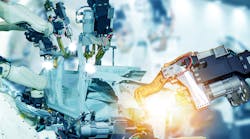Additive, Agility and Automation: a 2022 Triple Threat
As we close another year of living in the shadows of the pandemic, it’s likely that businesses and consumers will be more open to adopting technologies to get things done in new ways and from anywhere. Based on my interaction with leading product designers and manufacturers that are among our (PTC’s) customers, I believe that in 2022 there are “3A’s” that will become key business drivers: Agility, Automation and Additive.
Let me explain.
Agility Will be the Key to Competitiveness
The pandemic showed us the importance of business agility. Companies that were able to pivot thrived. From large retailers to mom-and-pop restaurants, those that quickly adapted to offer curbside deliveries and contactless ordering are still standing.
Similarly, many engineers adopted modern design platforms and evolved their product design process to be what might be called “agile everything” to adapt to the changing world. For example, Dixie Iron Works, a manufacturer of flow control equipment, provided a 3D printer to every engineer for their home so they could use collaborative design software (in this case, Onshape) to print tangible items, quickly vet ideas and ultimately get products to market faster.
To deal with the chip shortage, the engineers at Tesla developed new firmware that allowed them to source new chips from different suppliers.
In today’s digital era, organizations must be willing and equipped to adapt to rapid changes in almost everything: which products they make, who is on their teams, locations, supply chains, quantities, shortages, costs and more. To do so, they must have the right technologies and processes in place to collaborate and innovate in real time. Agility is the new competitive edge.
Automation Will Become Mainstream
Whether due to the Great Resignation, the relentless need for lower costs, or the desire to reduce human contact in the COVID world, almost all industries are facing skills shortages, placing additional pressure on current employees. While business leaders must find ways to stop employees from leaving the workforce, they also must run their businesses and meet customer demands simultaneously. I believe automation is the answer to helping manufacturers fill the skills gap, eliminate the time-taking processes in the warehouses and improve product quality. I expect to see a world of cobots, where robots and humans coexist and collaborate in factories and warehouses. More manufacturers will invest in cobots to take on the dull, dangerous and repetitive work, while humans focus on creative work. The result could well improve efficiency, increase production capacity and reduce costs. It’s no wonder the cobots market is expected to reach $10.5 billion by 2027.
Additive Will Boost Innovation
Additive manufacturing, like cloud-native, has changed the manufacturing landscape, making us rethink innovation and transforming the way we design and accelerate product development. To keep their supply chain flexible, companies may shift to digital inventory and on-demand manufacturing. In fact, given the disruption in the supply chain and the growing demand for medical supplies during the pandemic, I predict we’ll see the popularity of additive manufacturing skyrocket in 2022 and beyond.
In fact, the global 3D printing market is expected to grow to $34.8 billion by 2026, at a compound annual growth rate (CAGR) of 22.5%. Other factors that will drive demand include ever-improving part quality, availability of new materials and government investments in 3D printing projects. For innovators, these emerging additive technologies and high-performance materials will allow them to create and test functional prototypes and get products to market faster than ever.
Bottom line: The silver lining of the pandemic is the availability and adoption of a variety of digital platforms, whether we work from home, in an office or sometimes both. Each tool provides new benefits and new workflows—from cloud-native platforms that allow you to design in real-time to emerging tech that can accelerate product innovation. It’s now up to innovators and business leaders to take advantage of the right platforms, processes and people to boost their competitive edge.
Founder of Onshape and SOLIDWORKS, Jon Hirschtick is now executive vice president at PTC and general manager of its Onshape and Atlas divisions, responsible for driving strategy and growth, while empowering global businesses to shape the future.




